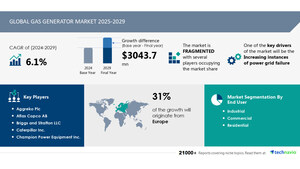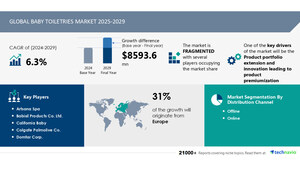NEW YORK, Aug. 26, 2024 /PRNewswire/ -- The global lithium-ion battery market size is estimated to grow by USD 448.8 billion from 2024-2028, according to Technavio. The market is estimated to grow at a CAGR of 42.93% during the forecast period. Augmented demand from consumer electronics is driving market growth, with a trend towards legislative support for battery recycling. However, growing popularity of fuel cell solutions poses a challenge. Key market players include A123 Systems LLC, AT and T Inc., BYD Co. Ltd., CLARIOS LLC, Envision Energy USA Ltd., Exide Industries Ltd., GS Yuasa International Ltd., Hitachi Ltd., Johnson Controls International Plc., LG Chem Ltd., Manz AG, Panasonic Holdings Corp., Samsung SDI Co. Ltd., Shenzhen Bak Battery Co. Ltd., SK Inc., Sony Group Corp., TDK Corp., Tesla Inc., TianJin Lishen Battery Joint Stock Co. Ltd., and Toshiba Corp..
Get a detailed analysis on regions, market segments, customer landscape, and companies- View the snapshot of this report
Lithium-Ion Battery Market Scope |
|
Report Coverage |
Details |
Base year |
2023 |
Historic period |
2018 - 2022 |
Forecast period |
2024-2028 |
Growth momentum & CAGR |
Accelerate at a CAGR of 42.93% |
Market growth 2024-2028 |
USD 448.8 billion |
Market structure |
Fragmented |
YoY growth 2022-2023 (%) |
33.19 |
Regional analysis |
APAC, Europe, North America, South America, and Middle East and Africa |
Performing market contribution |
APAC at 51% |
Key countries |
China, US, Norway, Germany, and Japan |
Key companies profiled |
A123 Systems LLC, AT and T Inc., BYD Co. Ltd., CLARIOS LLC, Envision Energy USA Ltd., Exide Industries Ltd., GS Yuasa International Ltd., Hitachi Ltd., Johnson Controls International Plc., LG Chem Ltd., Manz AG, Panasonic Holdings Corp., Samsung SDI Co. Ltd., Shenzhen Bak Battery Co. Ltd., SK Inc., Sony Group Corp., TDK Corp., Tesla Inc., TianJin Lishen Battery Joint Stock Co. Ltd., and Toshiba Corp. |
Market Driver
The global shift towards electric vehicles (EVs) due to increasing environmental concerns and regulations against fossil fuel-powered vehicles is driving the demand for lithium-ion batteries. Governments worldwide are introducing initiatives to promote EV adoption and recycling of lithium-ion batteries to mitigate environmental impact. For instance, China is offering subsidies and imposing restrictions on new fossil fuel-powered vehicle manufacturing. The European Union has formulated a directive for battery collection and recycling, but current rates are low. Lithium-ion batteries contain harmful materials, such as cobalt and lithium, which can contaminate groundwater and soil if not recycled properly. Recycling can extract these metals, reducing pressure on mining and creating economically sustainable business models. Companies like Umicore, Stiftung GRS Batterien, and Li-Cycle are leading in lithium-ion battery recycling, using smelting and leaching processes. Legislation on battery recycling is crucial to ensure ecological sustainability and prevent contamination. The growth of EVs and stricter regulations will fuel the lithium-ion battery market during the forecast period.
The Lithium-ion battery market is experiencing significant growth due to the increasing demand for rechargeable batteries in various industries. Energy efficiency and long-life are key trends driving this market. Traditional batteries like Lead-acid, Nickel-metal hydride, and Nickel-cadmium are being replaced by Lithium-ion batteries in passenger cars and consumer electronics. However, memory effect and ageing are challenges that need to be addressed. Integrated protection circuits ensure safe charging and discharging. Major players are focusing on strategic collaborations, mergers, and expertise management to meet the reliable power supply needs of the EV industry, EV sales, and renewable energy sector. Lithium and Cobalt are crucial raw materials, and supply chain disruptions can impact market prices. The automobile sector and consumer electronics are the major applications, with the EV industry expected to dominate the market's growth. Lithium-ion batteries are also being explored for use in lithium-air flow batteries.
Explore a 360° Analysis of the Market: Unveil the Impact of AI. For complete insights- Request Sample!
Market Challenges
- Lithium-ion batteries have long been the go-to energy storage solution for various industries, including automotive and material handling equipment. However, the increasing adoption of fuel cell systems poses a significant challenge for end-users. For instance, in warehouses where forklifts operate for extended hours, the frequent replacement or charging of lithium-ion batteries can cause logistical issues. Conventional batteries, such as lead-acid and lithium-ion, have a long recharging period, hold less energy per charge, and need replacement every 2-3 years. To address these challenges, fuel cells have emerged as a reliable and efficient alternative. Fuel cells convert stored chemical energy into electrical energy through an electrochemical reaction, offering higher efficiency and zero emissions. They are scalable and suitable for providing both backup and prime power in the stationary power sector. With fuel cells gaining traction in automotive applications, particularly in electric vehicles (EVs), the demand for lithium-ion batteries is expected to decline, impacting the market growth during the forecast period. Established automakers like Toyota Motor and Hyundai Motor are exploring fuel cell technology for next-generation EVs, offering longer range and faster refueling times. This shift towards fuel cells as a viable alternative to lithium-ion batteries will likely influence the market dynamics.
- The Lithium-ion battery market is experiencing significant growth, driven by the increasing demand for electric vehicles (EVs) in the automobile sector and consumer electronics. However, challenges persist, including supply chain disruptions for key components like Lithium and Cobalt. Major market players are responding through strategic collaborations and mergers. In the EV industry, lithium-ion batteries are the power sources of choice, with features like high power density, long life cycle, and high energy density. Anodes use graphite-based materials, while cathodes often consist of Lithium Titanate or Lithium Cobalt Oxide. The fundamental operation relies on an electrolyte solution and a selective membrane. Lithium-ion batteries are also used in small-sized electronic devices, aerospace, medical, marine, industrial, telecommunications, and renewable energy sectors. Alternatives like lithium-air flow batteries, solid-state batteries, and lead acid batteries are also under development. Lithium insertion materials, such as graphite and LiCoO2, play a crucial role in battery performance. Despite these advancements, improving conductivity and reducing costs remain key challenges.
For more insights on driver and challenges - Request a sample report!
Segment Overview
This lithium-ion battery market report extensively covers market segmentation by
- Type
- 1.1 Lithium nickel manganese cobalt
- 1.2 Lithium titanate
- 1.3 Lithium iron phosphate
- 1.4 Lithium cobalt oxide
- Application
- 2.1 Automotive
- 2.2 Consumer electronics
- 2.3 Energy storage and others
- Geography
- 3.1 APAC
- 3.2 Europe
- 3.3 North America
- 3.4 South America
- 3.5 Middle East and Africa
1.1 Lithium nickel manganese cobalt- Lithium-ion batteries with nickel, manganese, and cobalt compositions have gained significant market traction. The combination of nickel and manganese offers advantages: manganese's spinel structure creates low internal resistance, while nickel, despite its large specific energy, increases stability. These batteries are popular in power tools, e-bikes, electric drivetrains, laptops, mobile phones, portable gadgets, electric vehicles, and battery storage power plants. The lithium nickel manganese cobalt segment dominated the global lithium-ion battery market in 2023 and is projected to continue its dominance during the forecast period.
For more information on market segmentation with geographical analysis including forecast (2024-2028) and historic data (2017-2021) - Download a Sample Report
Research Analysis
The Lithium-Ion Battery Market is experiencing significant growth due to the increasing demand for electric vehicles (EVs) in the automobile sector and the expanding use in consumer electronics and renewable energy applications. Lithium and cobalt are key elements in the production of these batteries, but supply chain disruptions and ethical concerns surrounding their sourcing have led to research on alternative materials like graphite-based lithium-ion batteries. The market is characterized by strategic collaborations, mergers, and the development of new technologies to improve conductivity, longevity, and safety. Major market applications include EVs, power tools, small-sized electronic devices, laptops, mobile phones, and power sources for renewable energy systems. Lithium insertion materials like LiCoO2 are fundamental to the operation of these batteries, and their combination of high energy density, long cycle life, and features like fast charging make them the preferred choice for various industries.
Market Research Overview
The Lithium-ion battery market is witnessing significant growth due to the increasing demand for electric vehicles (EVs) in the automobile sector and the expanding use of lithium-ion batteries in consumer electronics and renewable energy sector. Lithium and cobalt are the key raw materials for producing lithium-ion batteries, which have become essential power sources for various applications. The fundamental operation of lithium-ion batteries involves the movement of lithium ions from the anode to the cathode during charging and discharging. Graphite-based lithium-ion batteries are commonly used due to their high conductivity and energy efficiency. The market is experiencing supply chain disruptions due to the increasing demand and limited availability of raw materials. Major market trends include strategic collaborations, mergers, and the development of new technologies such as lithium-air flow batteries, solid-state batteries, and Lithium Titanate. Lithium-ion batteries are used in various sectors, including aerospace, medical, marine, industrial, telecommunications, and power tools. The commercial market for lithium-ion batteries includes electric vehicles, renewable energy storage, and small-sized electronic devices. The batteries are rechargeable, and their power density, life cycle, energy efficiency, and memory effect make them a reliable power supply for various applications. The market is competitive, with various types of batteries, including lithium-ion, lead-acid, nickel-metal hydride, and nickel-cadmium, vying for market share. The expertise and management of major players play a crucial role in delivering reliable battery solutions to meet the growing demand for lithium-ion batteries.
Table of Contents:
1 Executive Summary
2 Market Landscape
3 Market Sizing
4 Historic Market Size
5 Five Forces Analysis
6 Market Segmentation
- Type
- Lithium Nickel Manganese Cobalt
- Lithium Titanate
- Lithium Iron Phosphate
- Lithium Cobalt Oxide
- Application
- Automotive
- Consumer Electronics
- Energy Storage And Others
- Geography
- APAC
- Europe
- North America
- South America
- Middle East And Africa
7 Customer Landscape
8 Geographic Landscape
9 Drivers, Challenges, and Trends
10 Company Landscape
11 Company Analysis
12 Appendix
About Technavio
Technavio is a leading global technology research and advisory company. Their research and analysis focuses on emerging market trends and provides actionable insights to help businesses identify market opportunities and develop effective strategies to optimize their market positions.
With over 500 specialized analysts, Technavio's report library consists of more than 17,000 reports and counting, covering 800 technologies, spanning across 50 countries. Their client base consists of enterprises of all sizes, including more than 100 Fortune 500 companies. This growing client base relies on Technavio's comprehensive coverage, extensive research, and actionable market insights to identify opportunities in existing and potential markets and assess their competitive positions within changing market scenarios.
Contacts
Technavio Research
Jesse Maida
Media & Marketing Executive
US: +1 844 364 1100
UK: +44 203 893 3200
Email: [email protected]
Website: www.technavio.com/
SOURCE Technavio

WANT YOUR COMPANY'S NEWS FEATURED ON PRNEWSWIRE.COM?
Newsrooms &
Influencers
Digital Media
Outlets
Journalists
Opted In




Share this article